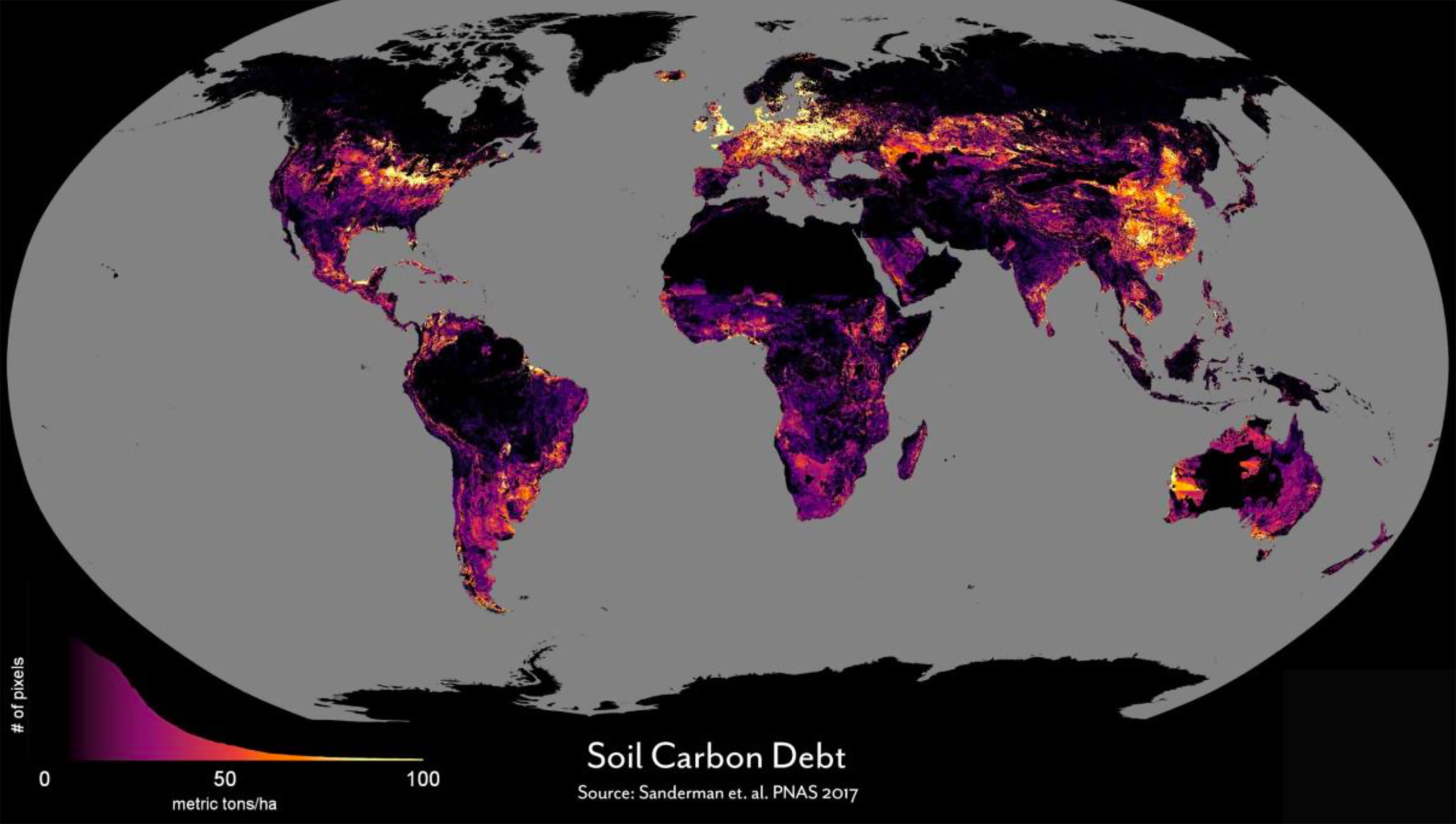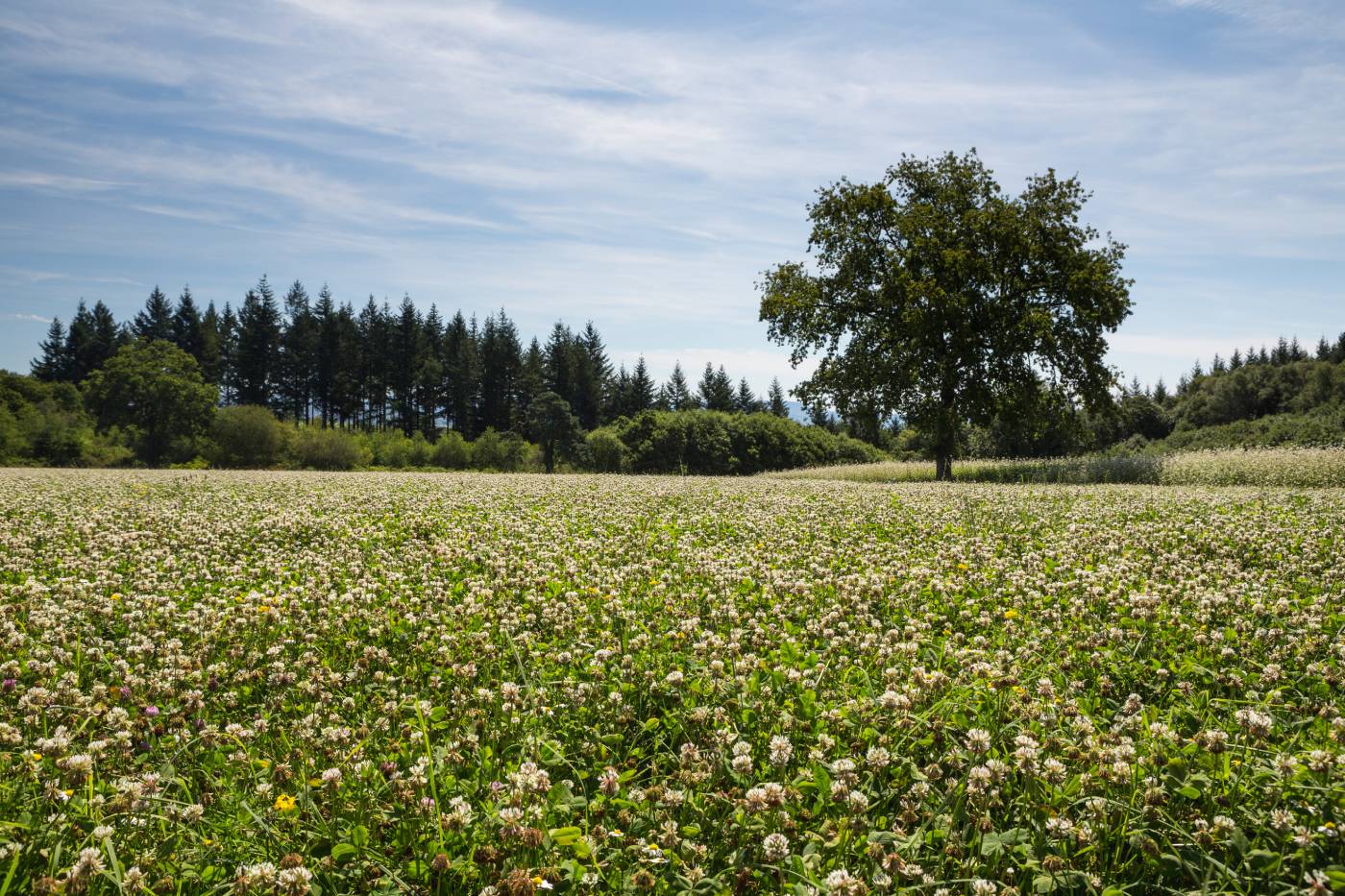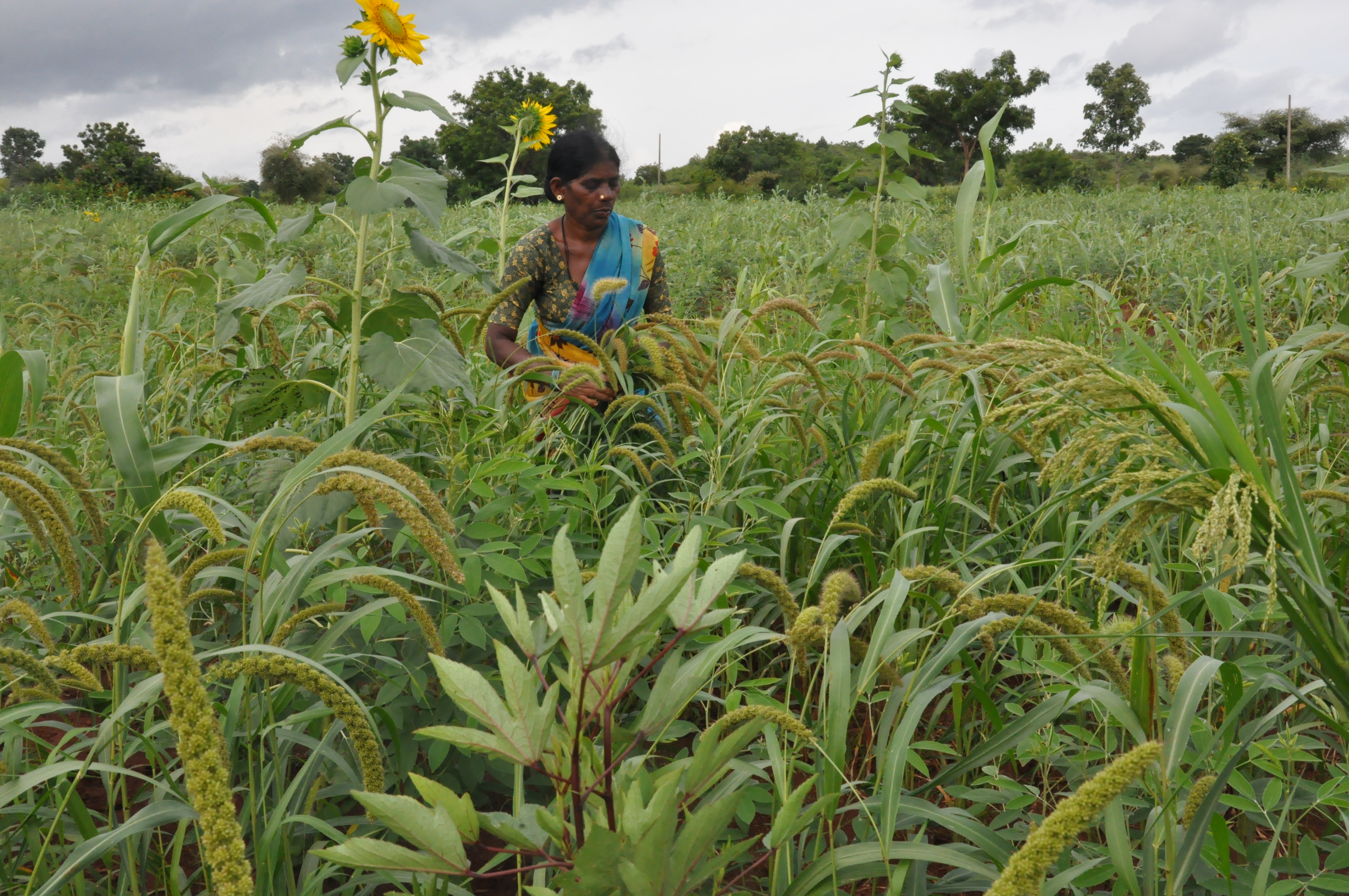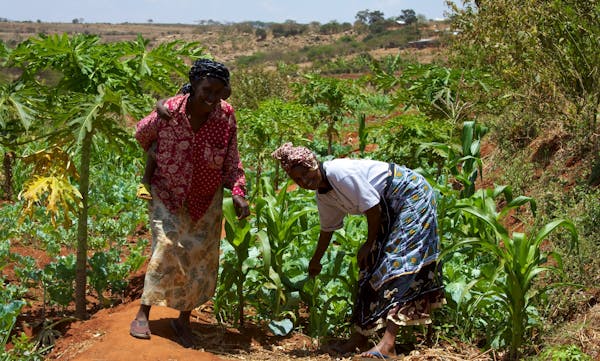Regenerative Agriculture can play a key role in combating climate change
- Regenerative Agriculture
- Regenerative Croplands
- Sustainable Rangelands
- Food Waste Reduction
- Circular Fibersheds
This commentary is a collaboration edited by Nuna Teal with contributions from several authors: Betsy Taylor, Karl Burkart, Keith Paustian, Rattan Lal, and Roland Bunch.
A growing consensus is emerging among soil scientists that regenerative agriculture – agricultural practices that remove carbon from the atmosphere and put it back in the soil – could deliver a huge win for the climate.
Since the beginning of agriculture, approximately 133 gigatonnes of carbon have been lost from soils globally, the equivalent of 480 GtCO2 emissions [1]. Much of this loss has occurred since the 19th century due to deforestation, overgrazing, plow-out of prairies, and drainage of wetlands in order to grow crops, as well as degradative practices such as intensive soil tillage, monoculture cropping, bare fallowing, and heavy reliance on the use of chemical fertilizers and biocides. These agricultural practices damage the microorganisms upon which fertile, carbon-rich soils depend.

Rather than functioning as a source of carbon emissions, croplands can become a carbon sink. At both the regional and global levels, a growing body of scientific literature is identifying the potential of regenerative agricultural practices in sequestering carbon, helping to mitigate climate change while making croplands more productive and resilient as the planet warms. But not all are in agreement.
In recent years, some extravagant claims have been made about the potential for soils to absorb as much as 1 trillion tonnes of carbon dioxide. This has caused a reaction by some experts who worry that this new “darling of policymakers, food companies, and farmers” will derail important mitigation efforts related to energy decarbonization, diet shifts, and other important solutions to climate change. This position is summed up by a recent article from World Resources Institute (WRI), “Regenerative Agriculture: Good for Soil Health…” which presents several criticisms regarding regenerative agriculture as a solution to climate change [2].
The response to the WRI article was swift, with leading soil scientists penning a formal rebuttal [3]. Below is a summary of the key points organized by seven key questions about the potential of regenerative agriculture, with points of agreement and disagreement between the two perspectives.
What is regenerative agriculture?
There seems to be a lack of clarity from WRI and others regarding the definition of “conservation” agriculture versus the larger umbrella of “regenerative” agriculture. So it’s important to begin by defining regenerative agriculture’s underlying principles, which are widely understood:
- maintaining continuous vegetation cover on the soil as much as possible
- reducing soil disturbance to promote the stabilization of organic matter on soil mineral complexes
- increasing the amount and diversity of organic residues returned to the soil
- maximizing nutrient and water use efficiency by plants
- restoring microbial life essential to soil health and biodiversity
Broadly speaking, these principles are designed to closely mimic a comparable native ecosystem. For example, a grassland prairie, which we know maintains much higher soil carbon stocks than conventional annual croplands in a given region. An array of practices can work to increase the amount of organic carbon added back into the soil while reducing the relative loss from erosion (C) and soil respiration (CO2). For annual croplands, these practices include:
- reduced tillage/no-till and cover crops
- diverse crop rotations with higher frequency of perennial crops
- grass cover for waterways and crop buffers
- agroforestry (e.g. hedgerows, windbreaks, tree cropping)
- conversion of marginal lands not suited for annual crops to perennial plantings
- integrated livestock management with improved grazing management
- utilization of compost and organic waste to build soil health

Are the benefits of regenerative agriculture clear?
WRI claims that the efficacy of these practices is up for debate, when in fact, there is now extensive literature representing hundreds of long-term field experiments across the globe that document the carbon sequestration efficiency of cover crops [4,5]; tillage reduction [6,7,8]; and improved grazing land management [9,10]. The field evidence that regenerative agricultural practices can significantly increase soil C stocks is unequivocal. Of course, results vary for different combinations of climate zones, soil types, and management systems. But regionally appropriate regenerative agroecosystems can now be designed with a relatively high degree of certainty about the long-term potential for carbon sequestration.
Are we accounting for soil carbon sequestration correctly?
WRI flags the potential for “double counting” of carbon sequestration, specifically importing carbon through organic amendments such as manure from off-farm sources without accounting for the emissions generated in the production of the manure. It goes without saying that understanding the net impact of such practices requires a broader life cycle assessment, and they may or may not result in a net reduction of greenhouse gas emissions [11]. However, estimates of global soil carbon sequestration potentials based on field experimental data generally do not include off-farm organic amendments as a key practice [12,13,14,15,16,17]. Double counting has, for the most part, been eliminated when estimating the overall potential for soil carbon sequestration.
Will regenerative agriculture reduce crop yields?
WRI speculates that the adoption of regenerative practices might cause significant yield declines compared to conventional agriculture and therefore increase pressure to convert forests to crop production, resulting in more carbon emissions. However, there is evidence demonstrating the potential for increases in agricultural yields resulting from increased soil organic matter [18,19], and yield intensification can result in less pressure for land-use conversion to agriculture. In fact, one of the more attractive features of using soils for carbon dioxide removal is that additional carbon can be stored in the soil without further land-use change. In contrast, land conversion is recognized as one of the major constraints against scaling up other removal approaches, including tree plantations (afforestation) or bioenergy with carbon capture and storage [20].
Won't increasing soil carbon require large additional quantities of nitrogen?
Soil scientists widely agree that practices to build up soil carbon will entail building up stocks of organically-bound nitrogen as well, at a ratio of roughly 11 to 1 (carbon to nitrogen). But this doesn’t mean that large amounts of synthetic nitrogen fertilizer will have to be produced to do so, as the WRI commentary implies. If this were the case, then the emissions resulting from the associated industrial fertilizer production would largely negate any climate benefits from the soil carbon sequestration. However, in most annual croplands in the industrialized world, there is currently an excess of added nitrogen. In fact, one of the key functions of cover crops is to capture nitrogen that otherwise could be leached to aquatic systems or lost as gaseous emissions.
Stabilizing nitrogen in organic matter via cover crops and improved crop rotation is a positive benefit. In the instance when nitrogen is not in excess, legume cover crops can promote the right soil balance through the biological fixation of nitrogen. There are many long-term experiments that demonstrate the capacity of improved crop rotations and cover crop adoption to increase soil organic matter while maintaining or increasing yields without requiring additional fertilizer nitrogen inputs compared to conventional management [21,4]. With proper management, regenerative agriculture can build up both organic soil carbon and nitrogen stocks while reducing nitrogen losses -- tightening up the problematic nitrogen cycle in our modern agricultural system.
Will it be difficult to scale regenerative agriculture globally?
This is the final challenge posed by WRI regarding the efficacy of soil carbon sequestration on croplands. While practices like cover cropping are growing in popularity, WRI believes that achieving widespread adoption across millions of farms would be difficult. In reality, more than 600 Mha of agricultural land is already under some form of conservation agriculture, growing at approximately 20 Mha per year [22]. Smallholder farmers, in particular, are rapidly scaling regenerative agriculture practices through regional peer-to-peer networks.
The “green manure” and cover cropping systems of Brazil and Paraguay are good examples, with over 3 million farmers now implementing this strategy across 25 Mha of land. In Africa, the farmer-managed natural regeneration of trees network (FMNR) has now spread to 24 Mha of previously barren land across ten nations. In Central America, the maize-mucuna crop rotation system has spread to 25,000 farmers across 3 nations. This large-scale deployment has occurred organically with very little government support. With small incentives in place, these and other agroecological practices could scale dramatically [23].

How much carbon dioxide can regenerative agriculture remove?
The question at hand is to understand the technical potential of the various solutions in our arsenal to combat climate change. While the science on soil carbon sequestration will advance significantly in the coming years, we now have a good sense of the potential. A comprehensive meta-analysis “Contributions of the land sector to a 1.5°C world” [24] establishes an estimate of 1.5 GtCO2/yr for cropland sequestration globally, or approximately 55 GtCO2 over a mid-range saturation period of 35-40 years [25]. And that doesn’t include practices like composting of municipal food waste [26]; tree cropping [27]; hedgerows and other cropland buffers as well as pasture restoration [13]; or biochar [25], all of which will significantly increase the potential for carbon removal on agricultural land. It is clear that regenerative agriculture, as a diverse portfolio of practices that can be adapted to specific regions and crop types, can and should play a major role in tackling climate change, with the potential to remove 100-200 GtCO2 by the end of the century.
Standing on common ground
One thing all scientists working in the field can agree upon is that a variety of practices are available that can avoid greenhouse gas emissions associated with our current agricultural system: reducing food waste, shifting towards plant-based diets, improving nitrogen efficiency on crops, and reducing on-farm energy use. These efficiency improvements are all fully compatible with regenerative agriculture. So why should the scientific community create artificial silos to decouple emission reductions from carbon removal? Regenerative agriculture practices can – and must – do both, especially when one considers that the main mechanism for the improvement in soil health, a principle that all soil scientists agree upon, is putting organic matter back into the soil.
Technical disputes aside, the rest of the world is rapidly embracing regenerative agriculture. The 4per1000 initiative, launched by the French government with 48 national and subnational members, provides technical support to aid countries in setting Nationally Determined Contributions (NDCs) under the Paris Climate Agreement, including agricultural climate solutions [28]. Several countries, including Japan, Canada, Uruguay, and Namibia, are preparing or have already submitted NDCs that include soil carbon. New Zealand has been a leader in international discussions on agriculture and soil carbon sequestration, demonstrating that improved management practices targeted to soils with the greatest sequestration potential can contribute significantly to offset the country’s greenhouse gas emissions [29]. Chinese scientists recently published a paper that identifies approximately 3-4 GtCO2 of carbon removal potential on mainland China’s agricultural land [30].
Subnational governments are also getting in the game with California leading the way. The State recently announced major incentives for farmers to incorporate regenerative agriculture practices through a new Natural & Working Lands Challenge led by the US Climate Alliance of 24 State Governors. Cities will also have a major role to play. San Francisco has been spearheading the most comprehensive program in the world to divert food waste from landfills, creating rich compost amendments to improve soil fertility and increase carbon storage. Globally, 1.3 billion tons of food is wasted, much of it from municipal areas, representing significant greenhouse gas emissions and a major opportunity to mitigate climate change. The Urban Sustainability Directors Network and the Carbon Neutral Cities Alliance recently launched the Urban Drawdown Initiative to replicate the San Francisco model, incorporating Colorado State's COMET planner tool to track and measure long-term carbon storage on farms.
.jpg)
Corporate actors are also getting serious about regenerative agriculture, with companies like Danone and General Mills paying farmers to adopt practices that increase soil carbon sequestration. Unilever recently announced it will be carbon neutral across its entire supply chain before 2040, launching a $1.1B restoration fund to help in the global transition to a more sustainable and equitable agricultural system. In the United States, conservation finance programs are emerging to assist farmers in becoming more profitable through regenerative practices [31].
Climate change mitigation, as well as food security, climate resilience, biodiversity, and soil health, are all interrelated parts of a new global imperative. The imperative is for humanity to fundamentally re-imagine our agricultural landscapes, designing them to provide not only sustaining services (food and fiber) but environmental services as well, including carbon sequestration and adaptation capacity. The science is clear that regenerative agricultural practices have the biophysical capability of contributing significantly to both soil health and climate change mitigation, and that’s a good thing.
There is no singular solution to rebalancing our global climate system. By now, it is universally accepted that many solution ‘wedges’ are required to reduce greenhouse gas emissions and remove carbon from the atmosphere, not the least of which is regenerative agriculture. The challenge is whether socio-economic and political barriers can be overcome to bring that transformation to scale. Those barriers are beginning to fall as governments, agricultural companies, financial institutions, consumers, and farmers are recognizing the great potential of building healthy soils to cool the planet.
Every economic stimulus package that contributes to rebuilding post-pandemic economies should include aid to help farmers make this transition -- from Thailand to Texas. So it’s more important than ever that the scientific community communicates a clear, data-driven message to inform policymakers and the general public about the potential of regenerative agriculture to combat climate change and increase food security worldwide.
Explore Regenerative Agriculture Stories-
-
[1] Sanderman, J. (2017). Soil carbon debt of 12,000 years of human land use. Proceedings of the National Academy of Sciences, 114(36), 9575 LP – 9580.
[2] Ranganathan, J. et al. (2020). Regenerative Agriculture: Good for Soil Health, but Limited Potential to Mitigate Climate Change, WRI.
[3] Paustian, K. et al. (2020). Climate Mitigation Potential of Regenerative Agriculture is significant! (PDF).
[4] Abdalla, M. et al. (2019). A critical review of the impacts of cover crops on nitrogen leaching, net greenhouse gas balance and crop productivity. Glob. Ch. Biol. 25(8):2530-2543.
[5] Poeplau, C. & Don, A. (2015). Carbon sequestration in agricultural soils via cultivation of cover crops–A meta-analysis. Agriculture, Ecosystems & Environment 200:33-41.
[6] Franzluebbers, A.J. (2010). Achieving soil organic carbon sequestration with conservation agricultural systems in the southeastern United States. Soil Sci. Soc. Am. J. 74:347–357.
[7] Ogle, S.M. et al. (2012). No-till management impacts on crop productivity, carbon inputs and soil carbon sequestration. Agriculture, Ecosystems & Environment. 149:37-49.
[8] Kravchenko, A. N. & Robertson, G. P. (2011). Whole-profile soil carbon stocks: the danger of assuming too much from analyses of too little. Soil Sci. Soc. Am. J. 75:235–240.
[9] Conant, R. T. et al. (2016). Grassland management impacts on soil carbon stocks: a new synthesis. Ecol. Appl. 27:662–668.
[10] Ogle, S.M. et al. (2004). Deriving grassland management factors for a carbon accounting method developed by the Intergovernmental Panel on Climate Change. Environ. Management 33:474-484.
[11] Ryals, R. et al. (2015). Long-term climate change mitigation potential with organic matter management on grasslands. Ecol. Appl. 25:531–545.
[12] Fuss, S. et al. (2018). Negative emissions—Part 2: Costs, potentials and side effects. Environmental Research Letters 13(6).
[13] Griscom, B. W. et al. (2017). Natural climate solutions. PNAS 114(44):11645-11650.
[14] Lal, R. (2004). Soil carbon sequestration impacts on global climate change and food security. Science 304:1623–1627.
[15] Paustian, K. et al. (2016). Climate-smart soils. Nature 532:49–57.
[16] Smith, P. et al. (2008). Greenhouse gas mitigation in agriculture. Philosophical Transactions of the Royal Society: Biological Sciences 363:789-813.
[17] Sommer, R. & Bossio, D. (2014). Dynamics and climate change mitigation potential of soil organic carbon sequestration. J. Environ. Manag. 144:83-87.
[18] Oldfield, E. et al. (2019). Global meta-analysis of the relationship between soil organic matter and crop yield. SOIL 5:15-32.
[19] Schjønning, P. et al. (2018) The role of soil organic matter for maintaining crop yields: Evidence for a renewed conceptual basis. In: Advances in Agronomy (Vol. 150, pp. 35-79).
[20] NASEM (2019). Negative Emissions Technologies and Reliable Sequestration: A Research Agenda. National Academies of Sciences, Engineering, and Medicine. Washington, DC: The National Academies Press. https://doi.org/10.17226/25259.
[21] Dick, W. A. et al. (1998). Impacts of agricultural management practices on C sequestration in forest-derived soils of the eastern Corn Belt. Soil & Tillage Research 47:235–244.
[22] Burgess PJ. et al. (2019) Regenerative Agriculture: Identifying the Impact; Enabling the Potential (SYSTEMIQ). 17 May 2019. Bedfordshire, UK: Cranfield University.
[23] Bunch, R. (2020). Why smallholder farmers are key to scaling regenerative agriculture: 10 case studies. One Earth.
[24] Roe, S. et al. (2019). Contribution of the land sector to a 1.5 °C world. Nature Climate Change. 9, pp. 817–828.
[25] Lorenz, K. & Lal, R. (2018). Carbon Sequestration in Agricultural Ecosystems. Springer Nature.
[26] Silver, W. et al. (2018). Carbon Sequestration and Greenhouse Gas Mitigation Potential of Composting and Soil Amendments on California’s Rangelands. California Natural Resources Agency (PDF).
[27] Teske, S. et al. (2019). Achieving the Paris Climate Agreement Goals, Springer, ch. 4.
[28] Wiese-Rozanova L. (2020). Soil Carbon in the Nationally Determined Contributions, CGIAR.
[29] McNally, S.R. et al. (2017). Soil carbon sequestration potential of permanent pasture and continuous cropping soils in New Zealand, NZAGRC.
[30] Tao, F. et al. (2019). Cropland soils in China have a large potential for carbon sequestration based on literature survey. Soil & Tillage Research 186: 70-78.
[31] Renton, C.A. et al. (2020). Farmers on the frontlines of the regenerative agriculture transition. Conservation Finance Network.
-







